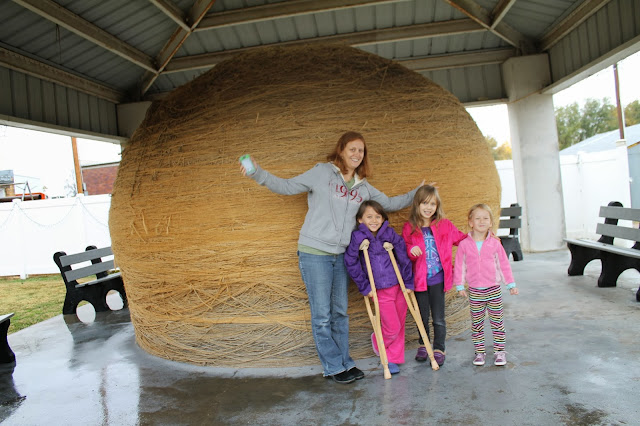The complete (and sometimes graphic) story of
Norah & the Toothpick...
 |
| Her mood changed this quick. |
Luckily, the nearest ER was ridiculously close, so
Jenny raced there for what we hoped would be a quick extraction. We
were wrong. The x rays turned up nothing. Not because you couldn't
tell there was a toothpick still in her. You could. It made a
cartoonish lump where it was sticking out the other end. No, because
it was made of wood, it apparently didn't read on an x ray. So,
without being able to exactly pinpoint its location, the orthopedist likened it to the proverbial 'needle in a haystack'. He worried
that more damage could possibly be done to Norah's foot by digging
around in it, if he couldn't quickly locate the toothpick. The
alternative was to wait. That's it. Take some antibiotics. Some pain
meds. And wait for the thing to work its way out.
So, that's what we did. We waited. We were told we should
follow up with another orthopedist in St. Louis, so we headed back
that afternoon. With her leg propped up on the seat in front of her,
we powered through Illinois quickly. Once back in St. Louis, we
started doing everything we could to coax that toothpick out of her.
And I don't mean the figurative 'everything'. I mean the literal one.
Everything. She soaked it in Epsom salts. Several times a day. We
tried salve. We tried just about every remedy that anyone
recommended. It read like a nice sized grocery list. Bananas. Soap.
Sugar. Bread. Milk. Salt. We learned what a poultice is. And we even
contemplated wrapping her foot in bacon. All this to try and help her
body works it magic, and start to eject the toothpick on its own. If
it would simply 'present' itself, (meaning the tip of it start to
poke back out) it could then be easily extracted. We waited some more. It wasn't easy at first. Norah's foot was swollen and she was in a lot
of pain. We kept the pain medication coming around the clock at first. We tried to make light of the situation. Clark nicknamed her The Gimp. Jenny called her Woody. The follow up visit
in St. Louis told us pretty much of the same. No digging around. Too
risky. Waiting was still our best option.
It had been almost a week now since the toothpick became a part of our life. Norah gimped through Halloween. We called her 'Woody the Peg Legged Pirate' (now with actual wood!) After the holiday, we were ready to hit the road, and Norah was starting to cope better now. Your body is pretty amazing sometimes. Once it recognizes a foreign body, it starts building up barriers around it, to make you more comfortable. It adapts to it. Some people incorrectly think that your body can 'absorb' or 'break down' something. It does not. It just builds up cushions around it and keeps it. For a long time sometimes. As we talked to others about Norah's condition, we heard many similar stories of things being poked into peoples bodies. For years sometimes. Decades other times. Then one day, pop, out they would come. These were not the stories we wanted to hear. We didn't need this toothpick to become a permanent member of our family.
 |
| Soaking rays, soaking feet. |
It was time to leave, and Norah still couldn't walk. We got her some crutches, brought our box of remedies, and hit the road. We had to alter some of our stops along the way, because there was too much hiking, or walking at them. Instead, we had lots of layovers along the way where the kids could swim. Indoor pools at hotels. Hot Springs pools. Hot tubs. We hit them all. They were great for a couple of reasons. It was something Norah could do without pain. And all that soaking was bound to help work that thing out of there. Certainly a few hours in a mineral rich hot spring would draw that thing right out, right? The entry hole which had closed up, was starting to look a little bigger. We were hopeful. Any day that toothpick would present itself.

Eventually Norah got better and better on her crutches. The swelling on her foot had gone down. The pain had pretty much subsided. She even started putting some weight on the side of that foot. Her body was doing its job. It was adapting to the toothpick. It just wasn't doing the 'pushing out the foreign body' kind of work that we were hoping for.
Once we finally arrived in Phoenix, Norah followed up with a 3rd orthopedist. This time we'd get different answers. They used ultrasound on her foot, and finally pinpointed the location of the toothpick. It was deep as we had thought. It was located between the 3rd and 4th metatarsal. It had not moved towards the entry wound as we had hoped. It was, in fact, still near the top of the foot. Surgery was set. It was coming out through the top.
 |
| Slightly larger than a needle. Her foot, slightly smaller than a haystack. |

Recovery was almost instant. No stitches. No big bandages. By the next day, she was already running around like normal, glad to be rid of her little wooden companion.
Goodbye Woody the Gimp.
Good riddance toothpick.













































